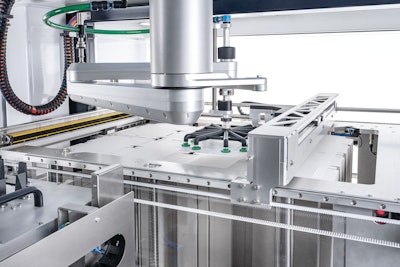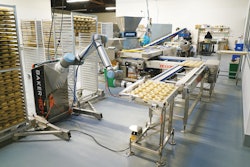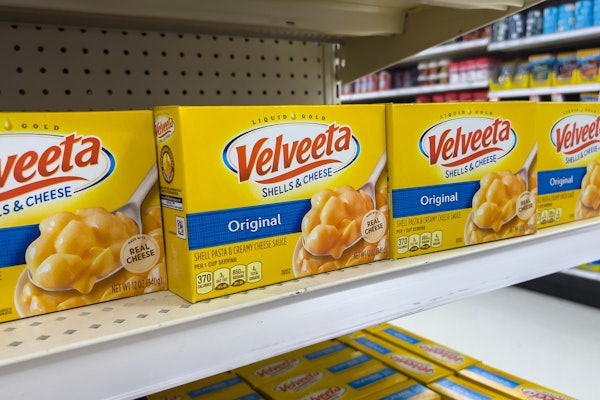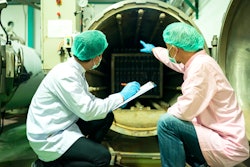
The trend toward greater customization of packaging, including pack sizes, configurations, and packaging types, to differentiate brands and connect with consumers continues to grow and with it, packagers’ need for greater flexibility. In response, packaging machinery suppliers are addressing this need with more flexible and modular systems for primary packaging that incorporate robots.
 Packaging Robotics: BluePrint Automation’s Spider 300v case-loading system
Packaging Robotics: BluePrint Automation’s Spider 300v case-loading system
According to BPA, another advantage of the machine is its compact footprint. Says the company, the Spider 300v is built with a new standard modular frame that has been designed to reduce cost by minimizing wiring and decreasing the footprint of the line by eliminating bulky external electrical cabinets.
 Packaging Robotics: The PKR Delta pick-and-place cell (l.) and the PKR Gantry robot (r.) from EndFlex
Packaging Robotics: The PKR Delta pick-and-place cell (l.) and the PKR Gantry robot (r.) from EndFlex
Says Jorge Perez, vice president of operations at EndFlex, “Our clients needed faster, more compact and precise modular cells to compete in their respective industries. They came to us with their wish lists and trusted us to find a solution. Our team of engineers and technicians got to work, and their efforts led to this new generation of robotic pick-and-place cells. The gantry and delta robotic cells we developed allow us to offer unique new solutions to some of the old packaging challenges.”
 Packaging Robotics: The Proco Collaborative Robot Packer
Packaging Robotics: The Proco Collaborative Robot Packer
 | Read Packaging World’s complete robotics report, "Robots 2023: Smarter, More Adaptable & More Robust." |
“We understand that labor shortages are becoming more common in the packaging industry, and that manufacturers need solutions that can help them reduce their labor costs and increase efficiency,” says John McCormick, president of Proco Machinery. “Our new collaborative robot packer is designed to be flexible, versatile, and easy to use, helping our customers stay competitive in their markets.”
The Proco Collaborative Robot Packer can perform a range of tasks, from testing containers to packing them into cases. The system is modular and on casters, making it flexible and easy to use, and can be adapted to different container shapes and sizes.
 Packaging Robotics: R.A Jones’ Intelligent Flexible Transfer System (iFTS)
Packaging Robotics: R.A Jones’ Intelligent Flexible Transfer System (iFTS)
The iFTS uses 2-, 3-, or 4-axis robots from Autonox Robotics that are driven by kinematics in the same controller that runs the main machine. Says R.A Jones, the use of the same controller provides a clean and open control architecture, reduced numbers of enclosures, and simplified machine wiring. Standard frame mounting, guarding, and overhead enclosures can be readily and safely adapted around other machines or configured to meet specific manufacturing requirements.
 Packaging Robotics: Schubert’s TLM Comfort Feeder
Packaging Robotics: Schubert’s TLM Comfort Feeder
 | Watch this related video, “The Automation Revolution: Robots Revolutionizing Packaging and Processing Tasks.” |
To feed the carton blanks into Schubert’s bar packer, a pallet with blank sheets is placed into the machine. The blanks are pre-cut and only connected at a few predetermined breaking points to form a sheet. For removal, a spacer fixes the sheet in place, while an F4 SCARA robot pulls each blank directly from the sheet one by one and deposits it into a vertical magazine that serves as a buffer. During this process, the pallet is gradually lifted until it reaches the last sheets. A camera also monitors the corner of each top sheet so that the robot can accurately access each blank.
Next, via Schubert’s new A6 carton erector, each blank is pulled individually from the bottom of the buffer and transferred to a pusher that transports it past the gluing unit to a folding box. There, a punch sucks up the blank, pushes it through the folding box for erecting and places it onto the transport system. In spite of its streamlined single-lane design, the unit achieves an output of 60 blanks/min due to its use of robotics. The feeder can also be used in Schubert machines without infeed from the pallet, but with a vertical magazine.
 Packaging Robotics: Shemesh Automation’s TKS-C60 robotics-enhanced packaging line for cosmetics
Packaging Robotics: Shemesh Automation’s TKS-C60 robotics-enhanced packaging line for cosmetics
 | Read how flexible end-of-line robotics let Molson Coors mix formats. |
The new line is designed to provide uninterrupted bottling of products that range from creams and foundations to fragrances and nail polish speeds to 60 bottles/min and incorporates a number of robots in different areas of the machine. ETNA, the line’s automatic bottle unscrambler, uses a delta robot supplied by ABB or Fanuc to provide precise bottle orientation, covering virtually all bottle types common to the cosmetics sector. Notes Shemesh, the robotic elements ensure no changeparts are required—except in some cases for the robot grippers—when unscrambling multiple different bottle shapes. Robots also ensure the bottles are facing the correct way for filling and capping.
Shemesh’s continuous-motion cosmetics capping machine, the Attilus, uses a robotic sorter based on a delta robot and an advanced vision system to enable higher speeds, enhanced accuracy, and flexibility in automatic screw, pump, and spray-cap sorting. The Attilus also uses a servo-controlled pick-and-place 2-axis gantry robot to track and deliver the caps to the bottles while in motion, ensuring smoother and faster production. Integrated with the Attilus and the gantry robot are a PLC and HMI from Siemens or Allen-Bradley that put the operator in control, allowing for simple programming, such as changing formats and the course of movement, at the touch of a button. The robotic enhancement of the Attilus also ensures changeover downtime is kept to a minimum of less than 20 minutes. PW





















